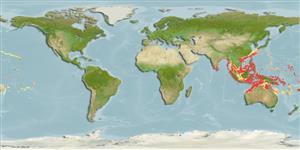Common names from other countries
>
Carangiformes (Jacks) >
Carangidae (Jacks and pompanos) > Caranginae
Etymology: Selar: A Malay vernacular name, ikan selar.
More on author: Cuvier.
Environment: milieu / climate zone / depth range / distribution range
Ökologie
seewasser riff-verbunden; tiefenbereich 35 - 500 m (Ref. 4233). Subtropical; 31°N - 23°S, 75°E - 134°W
Pacific Ocean: Andaman Islands to Vanuatu, north to the Philippines, south to northern Australia.
Size / Gewicht / Alter
Maturity: Lm ? range ? - ? cm
Max length : 25.0 cm FL Männchen/unbestimmt; (Ref. 4233); common length : 22.0 cm FL Männchen/unbestimmt; (Ref. 4233)
Rückenflossenstacheln (insgesamt) : 9; Rückenflossenweichstrahlen (insgesamt) : 23 - 25; Afterflossenstacheln: 3; Afterflossenweichstrahlen: 19 - 21.
Adults are found inshore and form large schools on day time. They disperse at night to feed on planktonic and benthic invertebrates such as crabs and shrimps. Eggs are pelagic (Ref. 4233, 7300, 90102).
Life cycle and mating behavior
Maturities | Fortpflanzung | Spawnings | Egg(s) | Fecundities | Larven
Paxton, J.R., D.F. Hoese, G.R. Allen and J.E. Hanley, 1989. Pisces. Petromyzontidae to Carangidae. Zoological Catalogue of Australia, Vol. 7. Australian Government Publishing Service, Canberra, 665 p. (Ref. 7300)
IUCN Rote Liste Status (Ref. 130435)
CITES (Ref. 128078)
Not Evaluated
Bedrohung für Menschen
Harmless
Nutzung durch Menschen
Fischereien: kommerziell
Tools
Zusatzinformationen
Download XML
Internet Quellen
Estimates based on models
Preferred temperature (Ref.
115969): 13.4 - 26.5, mean 20.4 (based on 400 cells).
Phylogenetic diversity index (Ref.
82804): PD
50 = 0.7500 [Uniqueness, from 0.5 = low to 2.0 = high].
Bayesian length-weight: a=0.01622 (0.00952 - 0.02762), b=3.02 (2.88 - 3.16), in cm Total Length, based on LWR estimates for this species & (Sub)family-body (Ref.
93245).
Trophic level (Ref.
69278): 3.5 ±0.41 se; based on food items.
Widerstandsfähigkeit (Ref.
120179): hoch, Verdopplung der Population dauert weniger als 15 Monate. (K=1.90).
Fishing Vulnerability (Ref.
59153): Low vulnerability (18 of 100).
